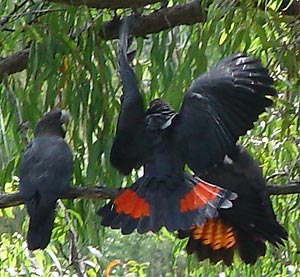

SEIPR Links
South East Iowa Parrot Rescue Home
Contact Us
Learning Folder
Parrots are birds of the roughly 350 species in 85 genera comprising the order Psittaciformes, found in most warm and tropical regions. Also known as psittacines (pronounced /ˈsɪtəsaɪnz/),[they are usually grouped into two families: the Psittacidae (true parrots) and the Cacatuidae (cockatoos). Characteristic features of parrots include a strong curved bill, an upright stance, strong legs, and clawed zygodactyl feet. Most parrots are predominantly green, with other bright colors, and some species are multi-colored. Cockatoo species range from mostly white to mostly black, and have a mobile crest of feathers on the top of their heads. Most parrots are monomorphic( male and female look alike) or minimally sexually dimorphic( male and female look different). Parrots, along with crows, jays and magpies, are some of the most intelligent birds, and their ability to imitate human voices enhances their popularity as pets. Trapping of wild parrots for the pet trade, as well as other hunting, habitat loss and competition from invasive species, have diminished wild populations, and more parrots are threatened with extinction than any other group of birds. The most important components of most parrots' diets are seeds, nuts, fruit, buds and other plant material, and a few species also eat insects and small animals, and the lories and lorikeets are specialised to feed on nectar from flowers, and soft fruits. Almost all parrots nest in tree holes (or nestboxes in captivity), and lay white eggs from which emerge altricial (helpless) young. Extant species range in size from the Buff-faced Pygmy-parrot, under 10 g (0.35 oz.) and 8 cm (3.2 inches), to the Hyacinth Macaw, at 1 meter (3.3 feet) in length, and the Kakapo, at 4 kg (8.8 lbs). They are the most variably sized bird order in terms of length. Some atypical parrots include the dimorphic Eclectus (the male is green and the female is red), the flightless lek breeding Kakapo. The Kaka, Kea and the Long-billed Corella have especially curved upper mandibles. Origins and evolution The diversity of Psittaciformes in South America and Australasia suggests that the order has a Gondwanan origin. The parrot family's fossil record, however, is sparse and their origin remains a matter of informed speculation rather than fact. A single 15 mm fragment from a lower bill (UCMP 143274), found in Lance Creek Formation deposits of Niobrara County, Wyoming, has been suggested as the first parrot fossil. Of Late Cretaceous age, it is about 70 million years old. But subsequent reviews have established that this fossil is almost certainly not from a bird, but from a caenagnathid theropod — a non-avian dinosaur with a birdlike beak. It is now generally assumed that the Psittaciformes or their common ancestors with a number of related bird orders were present somewhere in the world around the Cretaceous–Tertiary extinction event, some 65 mya (million years ago). If so, they probably had not evolved their morphological autapomorphies yet, but were generalized arboreal birds, roughly similar (though not necessarily closely related) to today's potoos or frogmouths (see also Palaeopsittacus below). Europe is the origin of the first generally accepted parrot fossils. The first is a wingbone of Mopsitta tanta, uncovered in Denmark and dated to 55 mya (million years ago). The climate at this time was tropical, consistent with the Paleocene-Eocene Thermal Maximum. Later fossils date from the Eocene, starting around 50 mya. Several fairly complete skeletons of parrot-like birds have been found in England and Germany. Some uncertainty remains, but on the whole it seems more likely that these are not direct ancestors of the modern parrots, but related lineages which evolved in the Northern Hemisphere but have since died out. These are probably not "missing links" between ancestral and modern parrots, but rather psittaciform lineages that evolved parallel to true parrots and cockatoos and had their own peculiar autapomorphies. Scientific classification Kingdom: Animalia Phylum: Chordata Class: Aves Order: Psittaciformes Wagler, 1830 Systematics (but see below) Family Cacatuidae (cockatoos) Subfamily Microglossinae (Palm Cockatoo) Subfamily Calyptorhynchinae (dark cockatoos) Subfamily Cacatuinae (white cockatoos) Family Psittacidae (true parrots) Subfamily Loriinae (lories and lorikeets) Subfamily Psittacinae (typical parrots and allies) Tribe Arini (American psittacines) Tribe Cyclopsitticini (fig parrots) Tribe Micropsittini (pygmy parrots) Tribe Nestorini (kakas and Kea) Tribe Platycercini (broad-tailed parrots) Tribe Psittrichadini (Pesquet's Parrot) Tribe Psittacini (African psittacines) Tribe Psittaculini (Asian psittacines) Tribe Strigopini (Kakapo) Copied from Wikipedia